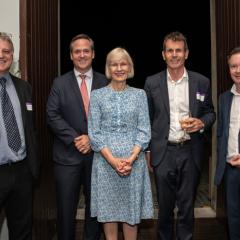Centre wins funding to inform the next generation of digital models used to guide management of the State’s groundwater and natural gas resources
The UQ Centre for Natural Gas has been awarded new funding to develop and integrate a range of advanced techniques to deliver continued improvements to subsurface, geological modelling that can be used by industry and government for groundwater and the extraction of the State’s gas resources.
The Centre has secured $356,435 of funding from the Australian Research Council (ARC) Linkage program for the project, which will investigate strategies to enhance geological models including those which will inform improvements in groundwater modelling in Queensland’s Surat Basin as the “test bed”. Outcomes will be broadly applicable to the modelling of a broad range of water and oil/gas resources, including in other basins in Australia and worldwide.
The project builds upon a large, comprehensive, long term research program currently funded by UQ and Centre members Arrow Energy, APLNG and Santos, bringing the total value of the project to over $1 million. This also includes significant data contributions from those industry players. The Centre’s researchers will also be working closely with the Queensland Government’s Office of Groundwater Impact Assessment (OGIA). This collaboration provides a unique opportunity to jointly build on modelling improvements that have been progressing in recent years, and already made Queensland a world-leader in this area.
Professor Andrew Garnett, the Director of the UQ Centre for Natural Gas, says that industry and government place a high level of importance on improving the effectiveness of geological models and “flow” models used for the estimation of gas resources and groundwater impact assessment.
“The techniques we develop will add to the foundation of both business and regulatory decision-making processes,” he says.
“While the currently available resource models are already complex and data rich, they can always be improved by developing better understanding of how genetically related sediment packages are arranged and distributed vertically and laterally.
“Patterns of sediment distribution greatly impacts estimates of the distribution, volume and connectedness of gas and water resources.”
The Surat Basin is an ideal location for the study as there is already quite a lot of data and research across the area due to the strict monitoring and reporting requirements in place for natural gas development. Each company builds flow models for their own developments and OGIA integrates the data to produce a model of cumulative groundwater flow.
While Queensland’s approach to gas and water management is held up globally as being world-leading, researchers, industry and government strive continuously to improve predictive confidence, as new techniques are developed and increasing levels of data becomes available. Building strong digital modelling capacity is an important mechanism in delivering the advances needed to provide more accurate estimation of gas and groundwater flows.
The first step in modelling is to correlate geological data from individual wells at different locations. The correlation process involves identifying the subsurface strata and the nature of the environment at the time those strata were laid down at each site i.e. the properties of the individual rock layers that the well has passed through, and then using a variety of techniques to estimate how the layers are distributed between adjoining wells. In this project, new geostatistical techniques will be used to systematically estimate properties in areas where there is no physical data.
The project will also increase the quantity and quality of data available to improve the correlation process by obtaining more detailed information about the ages of a key mineral (zircon) and fossils present in the sediments. This information will be used to ‘age-date’ key subsurface rock and sediment layers that are distributed across the region. This will then be fed into a new geostatistical methodology, which will then be applied to digital geological and fluid flow models.
The project team aspires to improve the predictive confidence of industry and government groundwater and resource models, including those relating to the Great Artesian Basins. This groundwater underpins some $12.8 billion of economic activity annually for Australia, supporting agriculture, industry, tourism, mining and urban water supply.
Responsible management of groundwater and natural resources is vital for Australia’s economy and society at large, making this project an important addition to the UQ Centre for Natural Gas’ research portfolio.



